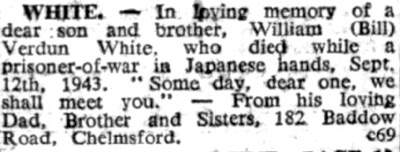William Verdun 'Bill' White served in the army during the war. He went overseas in late 1941, arriving in Singapore in January 1942 shortly before the Japanese invasion. He was captured by the Japanese in February 1942 and died in their hands in December 1944. His father lived in Baddow Road.
Bill was born in the Chelmsford district in 1916, the youngest son of Henry John White and Florence Eliza White (nee Saward); his middle name coming from the First World War battle. His siblings included Henry J. White (born 1913), Winifred Mons White (1914-1995) (also including a First World War battle as a middle name), and Dorothy E. White (born 1922).
Bill's mother died in Chelmsford & Essex Hospital in the summer of 1939.
During the Second World War Bill served as Private 6021186 in the 4th Battalion of the Suffolk Regiment.
Bill's battalion was sent overseas by ship late in 1941, arriving in Halifax, Nova Scotia, then on to Trinidad before reaching Cape Town, South Africa in December 1941. At that point it seemed to many in the battalion that it was heading for Egypt. However, by the end of the month the battalion was in Bombay, India and on 19th January 1942 it left for Singapore which was threatened by invasion by the Japanese. Bill and the rest of his battalion arrived in Singapore on 29th January 1942. Six days later it suffered its first casualties in combat. The Japanese advance continued and on 15th February 1942 Bill along with the rest of the battalion were captured by the Japanese following the surrender of the Commonwealth forces.
William Verdun WHITE, Private, 4th Battalion, Suffolk Regiment
Killed while a prisoner of war in Japanese hands in Burma. Aged 28
Many of the men in the 4th Battalion of the Suffolk Regiment suffered appallingly through a combination of brutality, disease and starvation. Bill died whilst a prisoner of war in Japanese hands on 21st September 1944 in Burma. He was 28 years old and was one of more than 250 men from the battalion to die whilst prisoners of war, many while working as forced labourers on the notorious Siam to Burma 'Death Railway'.
The railway, built by Commonwealth, Dutch and American prisoners of war, was a Japanese project driven by the need for improved communications to support the large Japanese army in Burma. During its construction, approximately 13,000 prisoners of war died and were buried along the railway. An estimated 80,000 to 100,000 civilians also died in the course of the project, chiefly forced labour brought from Malaya and the Dutch East Indies, or conscripted in Siam and Burma. Two labour forces, one based in Siam and the other in Burma, worked from opposite ends of the line towards the centre. The Japanese aimed at completing the railway in 14 months and work began in October 1942. The line, 424 kilometres long, was completed by December 1943.
Where found, the graves of those who died during the construction and maintenance of the railway (except for the Americans, whose remains were repatriated) were transferred from camp burial grounds and isolated sites along the railway into three cemeteries at Chungkai and Kanchanaburi in Siam (now Thailand) and Thanbyuzayat in Burma (now Myanmar). Today Bill lies in grave B1. L. 19. at Thanbyuzayat War Cemetery.
Other Chelmsford men who rest in the cemetery are: Reuben William Cecil Borley, Alexander Arthur Bowles, Leonard William Cole, Robert George Dance, Herbert George Grimwade, and Ernest Edward Royce.
At the time of his death Bill's father was living at 'Verdun Villa' 182 Baddow Road, Chelmsford.
111231
